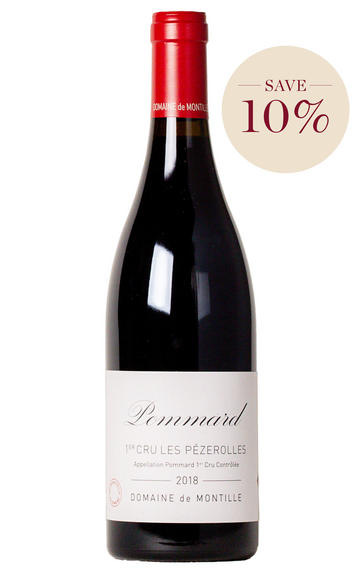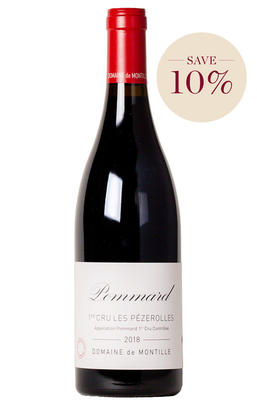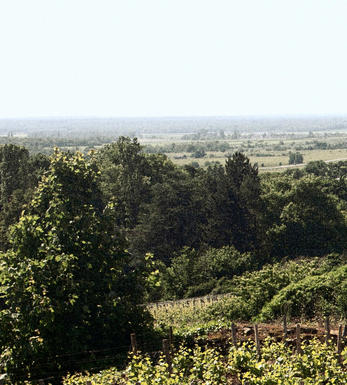
2018 Pommard, Les Pézerolles, 1er Cru, Domaine de Montille, Burgundy

Critics reviews
The 2018 Pommard 1er Cru Les Pezerolles was showing especially well, bursting from the glass with scents of orange rind, peonies, wild berries and cinnamon that's quite marked by its whole-cluster component. Medium to full-bodied, succulent and supple, it's ripe and enveloping, with supple, powdery tannins cloaked in a fleshy core of fruit.
Winemaker Brian Sieve has excelled himself in 2018, producing a portfolio of elegant, precise wines that bear the stamp of the vintage without being dominated by it. As was the case last year, some wines were quite tight-knit and reserved when I tasted them in December, but they will flesh out and open up considerably by the time they're bottled. A number of 2017s, revisited in bottle, had done just that.
As usual, comparatively long macerations with frequently significant percentages of whole cluster are the order of the day chez de Montille. And as I reported last year, following European Union legislation that prohibits one label from bearing the names of two appellations, the holdings of the Château de Puligny-Montrachet have now been incorporated into the Domaine de Montille, and they are accordingly reviewed here. There are no changes to the Maison de Montille négociant house, and those wines are reviewed under a separate heading in this report.
William Kelley, Wine Advocate (February 2020)
About this WINE

Domaine de Montille
The De Montille family has long been a venerable one in Burgundy, though Domaine de Montille’s reputation was properly established in 1947: prominent Dijon lawyer Hubert de Montille inherited 2.5 hectares in Volnay, later adding further parcels in Volnay, Pommard and Puligny. Hubert’s style was famously austere: low alcohol, high tannin and sublime in maturity.
His son, Etienne, joined him from ’83 to ’89 before becoming the senior winemaker, taking sole charge from ’95. Etienne also managed Château de Puligny-Montrachet from ’01; he bought it, with investors, in ’12.
The two estates were separate until ’17, when the government decreed that any wine estate bearing an appellation name could no longer offer wine from outside that appellation.
The solution was to absorb the château estate into De Montille – the amalgamated portfolio is now one of the finest in the Côte d’Or.
Etienne converted the estate to organics in ‘95, and to biodynamics in 2005, making the house style more generous and open, focusing on the use of whole bunches for the reds.

Pommard
The most powerful red wines of the Côte de Beaune emanate from Pommard, where complex soils with a high proportion of iron-rich clay produce deep-coloured, relatively tannic wines. A Pommard that is ready to drink in its first few years is probably not going to be a great example of the appellation.
Two vineyards stand out: the lower part of Les Rugiens, which has been mooted for promotion to Grand Cru status, and the five-hectare, walled Clos des Epéneaux, monopoly of Comte Armand.- 212 hectares of village Pommard
- 125 hectares of Premier Cru vineyards (28 in all). The finest vineyards include Les Rugiens, Les Epénots (including Clos des Epéneaux) and Pézérolles
- Recommended producers: Comte Armand, de Montille, de Courcel, J-M Boillot

Pinot Noir
Pinot Noir is probably the most frustrating, and at times infuriating, wine grape in the world. However when it is successful, it can produce some of the most sublime wines known to man. This thin-skinned grape which grows in small, tight bunches performs well on well-drained, deepish limestone based subsoils as are found on Burgundy's Côte d'Or.
Pinot Noir is more susceptible than other varieties to over cropping - concentration and varietal character disappear rapidly if yields are excessive and yields as little as 25hl/ha are the norm for some climats of the Côte d`Or.
Because of the thinness of the skins, Pinot Noir wines are lighter in colour, body and tannins. However the best wines have grip, complexity and an intensity of fruit seldom found in wine from other grapes. Young Pinot Noir can smell almost sweet, redolent with freshly crushed raspberries, cherries and redcurrants. When mature, the best wines develop a sensuous, silky mouth feel with the fruit flavours deepening and gamey "sous-bois" nuances emerging.
The best examples are still found in Burgundy, although Pinot Noir`s key role in Champagne should not be forgotten. It is grown throughout the world with notable success in the Carneros and Russian River Valley districts of California, and the Martinborough and Central Otago regions of New Zealand.


Buying options
Add to wishlist
Description
The price of the 75cl bottle, reduced from £120.50 previously, includes a 10% discount. This offer does not apply to BBX listings.
The 2018 Pommard 1er Cru Les Pezerolles was showing especially well, bursting from the glass with scents of orange rind, peonies, wild berries and cinnamon that's quite marked by its whole-cluster component. Medium to full-bodied, succulent and supple, it's ripe and enveloping, with supple, powdery tannins cloaked in a fleshy core of fruit.
Winemaker Brian Sieve has excelled himself in 2018, producing a portfolio of elegant, precise wines that bear the stamp of the vintage without being dominated by it. As was the case last year, some wines were quite tight-knit and reserved when I tasted them in December, but they will flesh out and open up considerably by the time they're bottled. A number of 2017s, revisited in bottle, had done just that.
As usual, comparatively long macerations with frequently significant percentages of whole cluster are the order of the day chez de Montille. And as I reported last year, following European Union legislation that prohibits one label from bearing the names of two appellations, the holdings of the Château de Puligny-Montrachet have now been incorporated into the Domaine de Montille, and they are accordingly reviewed here. There are no changes to the Maison de Montille négociant house, and those wines are reviewed under a separate heading in this report.
William Kelley, Wine Advocate (February 2020)
wine at a glance
Delivery and quality guarantee